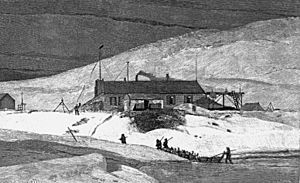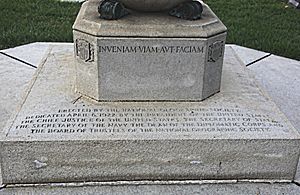Fort Conger facts for kids
Quick facts for kids Fort Conger |
|
|---|---|
| Grinnell Land, Ellesmere Island, Canadian Arctic | |

Fort Conger in May 1883
|
|
| Coordinates | 81°43′N 64°43′W / 81.717°N 64.717°W |
| Type | Scientific research post |
| Site information | |
| Operator | United States Army Signal Corps |
| Site history | |
| Built | August 1881 |
| In use | 1881–1935 |
| Materials | Wooden boards; tar paper |
| Events | Lady Franklin Bay Expedition |
Fort Conger is a historic site in the Canadian Arctic. It used to be a settlement, a military post, and a place for scientific research. It is located in the Qikiqtaaluk Region of Nunavut, Canada.
Fort Conger was set up in 1881 as a camp for exploring the Arctic. It became famous as the site of the first major scientific trip to the northern polar region. This trip was called the Lady Franklin Bay Expedition. It was led by Adolphus Greely and was part of the United States government's effort for the First International Polar Year. Later, the famous explorer Robert Peary also used Fort Conger during some of his Arctic journeys.
You can find Fort Conger on the northern shore of Lady Franklin Bay. This is in Grinnell Land, which is part of northeastern Ellesmere Island. It is inside Quttinirpaaq National Park. Even though there aren't many trees, the area has lots of grasses. The land around it is rough, with tall cliffs around the harbor. Fort Conger is now empty, but it is one of the few places in the Queen Elizabeth Islands that used to have people living there. In 1991, some of the buildings at Fort Conger were named important heritage sites by the Canadian government.
Contents
History of Fort Conger
Before Fort Conger was built, its harbor was used by the crew of the ship HMS Discovery. This happened during the British Arctic Expedition in 1875, led by George Nares. Nares left some supplies behind, but most of them were not found when Fort Conger was built in 1881.
The Lady Franklin Bay Expedition
Fort Conger was set up as a research base in 1881 during the Lady Franklin Bay Expedition. This expedition was led by a U.S. Army officer named Adolphus Greely. Greely named the fort after U.S. Senator Omar D. Conger, who had supported the expedition.
For two years, 25 people lived and worked at Fort Conger. This group included officers, soldiers, and Inuit people. They did important research about the Arctic. Greely later became a high-ranking officer in the Army. He received the Medal of Honor in 1935 for all his achievements.
Robert Peary's Expeditions
During his 1899 trip to reach the North Pole, Robert Peary arrived at Fort Conger. While there, he suffered from severe frostbite, which caused several of his toes to break off. He had to stay in bed for many weeks to get better.
While recovering, Peary wrote a famous quote on a wall: Inveniam viam aut faciam. This means "I shall find a way or make one." These words were supposedly said by the ancient general Hannibal before he crossed the Alps mountains. Later, this quote was carved onto the monument at Peary's grave in Arlington National Cemetery.
Two more groups from Peary's expeditions came back to Fort Conger in 1905 and 1908. Other explorers also used Fort Conger as a base from 1915 to 1935. In 1937, the MacGregor Arctic Expedition tried to use Fort Conger again.
Building Fort Conger
The first building at Fort Conger was 18 meters (about 59 feet) long, 5 meters (about 16 feet) wide, and 3 meters (about 10 feet) high. It had three rooms. There were also smaller shelters on each side of the building to store supplies.
The main building had double walls made of long wooden boards, covered with tar paper. However, this type of building was not good for the Arctic. It was very hard to keep the building warm inside.
Robert Peary thought the original Fort Conger was "grotesque" because it was so bad for polar winters. He eventually took down the first building. He reused the wood to build several smaller buildings that were connected. Some of these smaller buildings are still standing today and are protected as Federal Heritage Buildings.
Scientific Research at Fort Conger
As a science station, Fort Conger has been a place for many research projects. Early studies included "Pendulum Observations," which likely measured gravity. More recently, the University of Minnesota studied "microbes attacking the historic woods at Fort Conger."
Scientists have also found a lot of arsenic at Fort Conger. This chemical was probably brought there to help preserve samples for research. In 2013, a detailed report about the history of Fort Conger was published in a science journal called Arctic.



